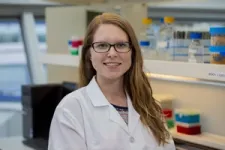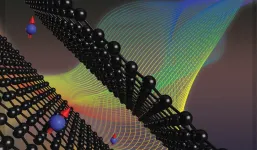(Press-News.org) GRAND RAPIDS, Mich. (May 11, 2023) — Van Andel Institute scientists have pinpointed how a specific gene mutation triggers an inflammatory cascade that may drive development of treatment-resistant cancers.
The new findings, published today in Molecular Cell, reveal for the first time the molecular circuitry by which mutations in the gene STK11 cause inflammation to spiral out of control. The resulting chemical firestorm damages healthy cells and can enable cancer development. Tumors that lose the STK11 gene are tough to treat because they resist traditional chemotherapy and many of the latest immunotherapies.
“Understanding how and why this mutation leads to cancer is a critical step in developing improved treatments,” said Russell Jones, Ph.D., chair of VAI’s Department of Metabolism and Nutritional Programming and the study’s corresponding author. “Our study identifies important features of these cancers and suggests that targeting inflammation may make these tumors more responsive to treatment.”
STK11 mutations occur when the instructions encoded by the gene are disrupted. This causes the gene to produce insufficient levels of the protein LKB1, a tumor suppressor that keeps cell growth under control. Loss of LKB1 derails critical cellular checks and balances and allows cancerous cells to grow unimpeded.
Loss of LKB1 is among the most common genetic mutations in human cancer, especially treatment-resistant lung cancer and pancreatic and cervical cancers. It also is the main player in the rare disease Peutz-Jehgers Syndrome. People with Peutz-Jehgers Syndrome develop polyps in their digestive tract and have a significant increase in cancer risk.
Although LKB1 has long been linked to cancer, it was not clear exactly how it worked to promote tumor growth. Earlier research by Jones and colleagues hinted that control of inflammation by LKB1 may be the culprit but the mechanism was unknown. Today’s findings offer a clearer picture of the process.
LKB1 works in part by regulating inflammation, which is a normal part of the body’s defense mechanisms against injury and infection. When LKB1 is lost, it triggers an epigenetic change in cells, which affects how the instructions encoded in DNA are acted upon. This results in rampant inflammation that damages healthy cells and may push them closer to malignancy.
“It’s a perfect storm of problems for which we now have potential solutions,” said Shelby Compton, a Van Andel Institute Graduate School Ph.D. student and the study’s first author. “In addition to cancer, I hope this work will inform new therapeutic strategies for Peutz-Jehgers Syndrome, which has few treatments and no cure.”
The next step, Jones says, is to “put ideas into action” by developing strategies to target inflammation in LKB1-associated cancers. The team also plans to continue exploring LKB1 in Peutz-Jehgers Syndrome with the goal of working toward new, much-needed therapies for people with this condition.
Authors include Susan M. Kitchen-Goosen, Lisa M. DeCamp, Kin H. Lau, Ph.D., Batsirai Mabvakure, Ph.D., Matthew Vos, Kelsey S. Williams, Ph.D., Xiaobing Shi, Ph.D., Scott B. Rothbart, Ph.D., and Connie M. Krawczyk, Ph.D., of VAI; and Kwok-Kin Wong, M.D., Ph.D., of NYU Langone Health.
Research reported in this publication was supported by Van Andel Institute.
###
ABOUT VAN ANDEL INSTITUTE
Van Andel Institute (VAI) is committed to improving the health and enhancing the lives of current and future generations through cutting-edge biomedical research and innovative educational offerings. Established in Grand Rapids, Michigan, in 1996 by the Van Andel family, VAI is now home to more than 500 scientists, educators and support staff, who work with a growing number of national and international collaborators to foster discovery. The Institute’s scientists study the origins of cancer, Parkinson’s and other diseases and translate their findings into breakthrough prevention and treatment strategies. Our educators develop inquiry-based approaches for K-12 education to help students and teachers prepare the next generation of problem-solvers, while our Graduate School offers a rigorous, research-intensive Ph.D. program in molecular and cellular biology. Learn more at vai.org.
END
PROVIDENCE, R.I. [Brown University] — For two decades, physicists have tried to directly manipulate the spin of electrons in 2D materials like graphene. Doing so could spark key advances in the burgeoning world of 2D electronics, a field where super-fast, small and flexible electronic devices carry out computations based on quantum mechanics.
Standing in the way is that the typical way in which scientists measure the spin of electrons — an essential behavior that gives everything in the physical universe its structure — usually doesn’t work in 2D materials. This makes it incredibly difficult to fully understand the materials and propel forward technological ...
CHICAGO, May 11, 2023 – You may know how other planets look, like the rust orange, dusty surface of Mars or the vibrant teal of Uranus. But what do those planets sound like?
Timothy G. Leighton from the University of Southampton in the U.K. designed a software program that produces extraterrestrial environmental sounds and predicts how human voices might change in distant worlds. He will demonstrate his work at the upcoming 184th Meeting of the Acoustical Society of America, running May 8-12 at the Chicago Marriott Downtown Magnificent Mile Hotel. His presentation will take place ...
Answers could be cloudy for researchers using Landsat images to investigate the coverage of the continental United States. The National Land Cover Database (NLCD) are useful products for scientists to understand how things like tree canopy and road coverage changes over time, but something as simple as cloud coverage can be misinterpreted in the satellite images as a significant surface coverage change. How can researchers be sure they’re getting a truly representative understanding of any one area?
The answer lies in composite ...
About The Study: In this study of more than 45,000 individuals drawn from the French general population, COVID-19–like symptoms, but not SARS-CoV-2 infection, during the first months of the pandemic were associated with an increased occurrence of subsequent depression and anxiety eight months or more after the occurrence of COVID-19–like symptoms, even when SARS-CoV-2 serologic test results were negative.
Authors: Alexandra Rouquette, M.D., Ph.D., of the Université de Versailles Saint-Quentin-en-Yvelines in Paris, is the corresponding ...
About The Study: The number of U.S. cancer survivors with self-reported functional limitation has more than doubled during the past 20 years, with relatively less growth in the number of limitation-free survivors.
Authors: Vishal R. Patel, B.S., of the University of Texas at Austin, is the corresponding author.
To access the embargoed study: Visit our For The Media website at this link https://media.jamanetwork.com/
(doi:10.1001/jamaoncol.2023.1180)
Editor’s Note: Please see the article for additional information, including other authors, ...
Overuse of antibiotic prescriptions for patients with upper respiratory illnesses at urgent care clinics in the United States has been an ongoing challenge, but a new study led by researchers at two Utah health systems – Intermountain Health and University of Utah Health – finds that a targeted approach utilizing antibiotic stewardship practices significantly reduces overuse of these medications.
In this Centers for Disease Control and Prevention (CDC) funded study, published today in JAMA Network ...
University of Cambridge media release
Obesity accelerates loss of COVID-19 vaccination immunity, study finds
UNDER STRICT EMBARGO UNTIL 16:00 (UK TIME) / 11:00 (US ET) ON THURSDAY 11 MAY 2023
The protection offered by COVID-19 vaccination declines more rapidly in people with severe obesity than in those with normal weight, scientists at the Universities of Cambridge and Edinburgh have found. The study suggests that people with obesity are likely to need more frequent booster doses to maintain their immunity.
Clinical trials have shown that COVID-19 vaccines are highly effective at reducing symptoms, hospitalisation and deaths ...
A common chemical reaction that most people have seen first-hand is the inspiration for a new way to make a flexible gel film that could lead to innovations in sensors, batteries, robotics and more.
A research team led by Texas Engineers developed what they call a "dip-and-peel" strategy for simple and rapid fabrication of two-dimensional ionogel membranes. By dipping sustainable biomass materials in certain solvents, molecules naturally respond by arranging themselves into functional thin films at the edge of the material that can easily be removed using nothing more than a simple set ...
Glioblastoma cancer cells use mitochondria from the central nervous system to grow and form more aggressive tumors, according to new Cleveland Clinic-led findings published in Nature Cancer.
The research showed that it is common for healthy astrocytes – a type of glial cell with important functions in the central nervous system – to transfer the energy-producing organelles to glioblastoma cancer cells. When this process happens, it makes the cancer more deadly and the tumors more likely to grow. Researchers found that acquiring mitochondria ...
UCLA researchers have developed an “all-in-one,” next-generation statistical simulator capable of assimilating a wide range of information to generate realistic synthetic data and provide a benchmarking tool for medical and biological researchers who use advanced technologies to study diseases and potential therapies. Specifically, the new computer-modeling – or “in silico” – system can help researchers evaluate and validate computational methods.
Single-cell RNA sequencing, called single-cell transcriptomics, is the foundation for analyzing genetic makeup (genome-wide gene ...






